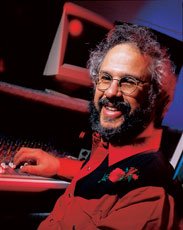By Steve Oppenheimer
(August 2000)
Something about the versatility of MIDI encourages me to dream up unusual things I can do with it. Of course, you can accomplish strange and wonderful things with a MIDI keyboard and a sequencer, but if you want to do something completely different, alternative controllers are a big help. Fortunately, EM associate editor Gino Robair and assistant editor Marty Cutler also are outspoken about their love for things alternative, so when I asked them to write an overview of the current alternative controller scene (see “The Outer Limits” on p. 48), they jumped at the chance.
To keep the project manageable, we concentrated on devices that are played like instruments, rather than MIDI processors and control surfaces. We also had to define what the heck alternative meant in this context. For instance, Marty’s beloved MIDI banjo is not the sort of thing you see every day, but it’s mainstream compared with Laetitia Sonami’s Lady’s Glove.
Ultimately, we chose to focus on the sci-fi world of controllers that are not simply MIDIfied traditional instruments. Finding some of these designers and controllers was a major challenge; you can’t simply round up the usual suspects. So we asked well-known musician, instrument designer, and author Bean Blaine for help. Inspired, Bean turned in three times as much copy as we asked for-all good stuff. In short, we went over the top.
Longtime contributor Paul Lehrman also has a bent for over-the-top, creative musical solutions. In “Rediscovering the Ballet Mecanique” (p. 74), he describes the daunting challenges he faced in producing a modern performance of George Antheil’s brilliant work. The original 1924 score called for 16 player pianos performing in sync, an impossibility in Antheil’s day. Lehrman met the challenge by writing a huge, complex sequence to control Yamaha Disklaviers and digital pianos. I attended Lehrman’s performance of Ballet mecanique with the San Francisco Symphony and was blown away. Bravo, Paul!
On the other end of the spectrum from unique controllers and Disklaviers are products we commonly take for granted, such as the humble keyboard stand. I hate to think about the money I’ve wasted on keyboard stands I later came to dislike because they lacked pedal space, were unstable, and so on. I wish I could have read “Stand and Deliver” (p. 92) long ago. And who better to write it than longtime touring and studio keyboardist Julian Colbeck?
But we didn’t let Julian just piddle about with keyboard stands all month. So this month, we’re introducing a new column, “Vintage Page” (p. 30). Each month, Julian will list the ten most popular vintage keyboards and synth modules, ranked according to the latest used-instrument sales and rental figures. He’ll briefly explain which attributes make the instruments popular today, with an in-depth discussion of that month’s hottest instrument. Starting next month, we will show both the current and the previous month’s rankings so you can see what has remained hot over time.
